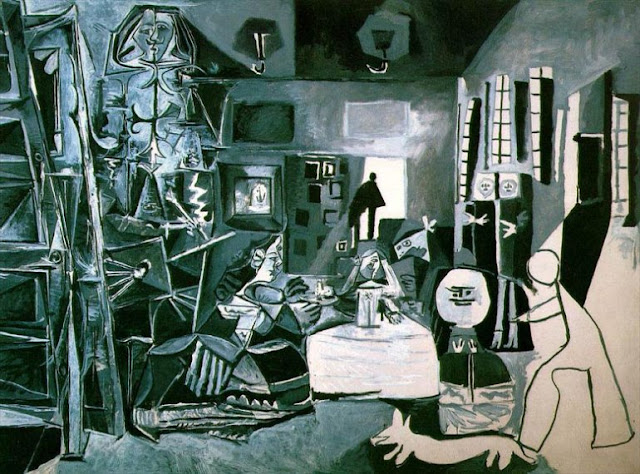Las Meninas, 1656
Museo del Prado, Madrid, Spain
 |
| Source: Museo del Prado |
This is the most famous painting of Diego Velázquez. Velázquez portrayed himself, painting the painting itself, on the left of the canvas. Margarita, daughter of Felipe IV, wore white and appeared in the center of the composition, surrounded by her ladies in waiting, the “meninas”, along with two court buffoons and a mastiff. Behind her, the duenna was talking to the quartermaster. The King and Queen, Felipe IV and Maria de Austria, were reflected in the mirror at the back of the room. (Source: http://www.museodelprado.es/en/the-collection/online-gallery/on-line-gallery/obra/the-family-of-felipe-iv-or-las-meninas/)
If I am not wrong, portrait paintings used to be one dimensional where people stand in 1 line across the drawing board. This painting differs from the norm and is famous for its series of complex spatial relationship, which gives it a photography-like realism.
I had seen Picasso's and Dali's interpretations of this picture first before I subsequently saw Velázquez's in Madrid. When I saw Cane's interpretation in Nice, I became slightly fascinated and amused.
Picasso
Las Meninas, 1957
Museu Picasso, Barcelona, Spain
There were at least 40 paintings on different aspects of Las Meninas by Picasso. I am not a huge fan of Picasso because half of the time, I cannot appreciate his techniques and other half of the time, what he was painting. What impresses me, however, is the perfection he seemed to want to achieve. Maybe he was obsessive, maybe he was mad. Maybe they were just doodles that people now appreciate as 'art'. Whatever the case, he showed that he experimented, practised and worked at it until he was satisfied. He did not become great/ famous just by some stroke of luck. He put in the hours and relentless effort:
Salvador Dalì
I cannot quite remember where I saw Dali's takes (not sure if it was one of the Dalì museums or the Reina Sofia in Madrid). Like a lot of his other works, Dali included his muse and wife, Gala, in his interpretation:
 |
| Source: wikipainting.org |
And his more abstract version:
 |
| Source: wikipainting.org |
There are a lot of stories about the number 8 in this painting but it is also understandable that I go "what the...".
Louis Cane
Ménines classiques II, 1982
Musée d'Art Moderne et d'Art Contemporain, Nice, France
Musée d'Art Moderne et d'Art Contemporain, Nice, France
 |
| Isn't this cheeky? |






No comments:
Post a Comment